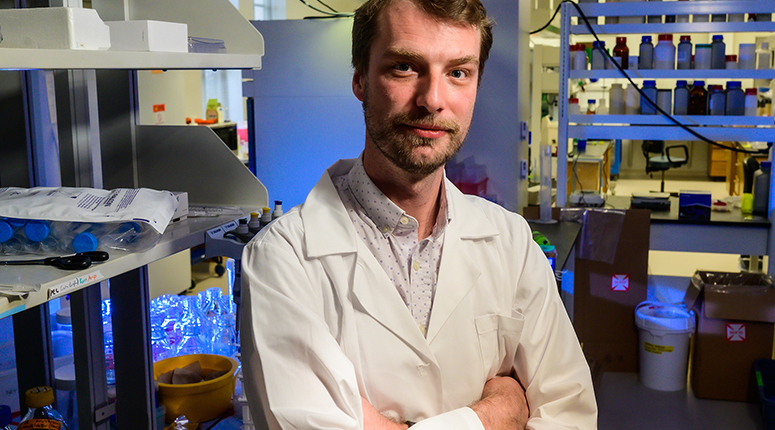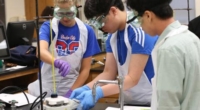James Chappell, a researcher at Rice University, is using RNA technologies to program microbial communities to coexist and work together. Chappell and his team believe that this could lead to developing new functions for microbes that improve crop yields, human health, and global sustainability. By transferring genetic programs between individual microbes, the researchers aim to control and program communities of microbes that coexist or work together in a common living space. Additionally, they plan to implement spatiotemporal control in messy environments to create genetic programs that can be selectively activated at specific times or in specific places. The lab has been awarded a five-year research grant to investigate renewable energy applications of RNA programs that selectively control the flow of energy in microbial consortia. Finally, the team could potentially use artificial intelligence or other computational techniques to automate the design of microbial programming.
Rice University bioscientist and synthetic biologist, James Chappell, has been granted the National Science Foundation CAREER Award. This award will allow him to work on developing RNA programming methods that can benefit human health and the environment. As an assistant professor of biosciences and bioengineering, Chappell wants to take the engineered RNA systems they have developed and apply them to programming communities of microbes in complex and diverse environments.
Synthetic biology has come a long way over the last decade, and microbes have been genetically programmed in ideal laboratory environments. However, many microbes exist in less-than-ideal environments. Chappell’s goal with this award is to find a way to program communities of microbes in these environments to improve the health of humans and the environment.
CAREER awards are prestigious early-career honors that recognize young scientists who have the potential to serve as academic role models in research and education. The NSF only grants approximately 500 CAREER Awards across all academic disciplines annually, making it a significant achievement for Chappell, who is one of nine Rice faculty members to receive this award in 2023.
Chappell has been researching RNA systems and biotechnologies since joining Rice University in 2017. RNA and DNA are molecules made of long chains of nucleotides. While DNA is used to store genetic information, RNA is used to access and act on that stored information. Cells also use RNA to turn genes on and off, catalyze chemical reactions, and sense molecular and environmental cues.
According to Chappell, “We need analogous frameworks to program the native microbial communities that are all around us in soils, rivers, our built environment, and even our own bodies.” Microbial communities are groups of microbes that share a living space and either coexist peacefully or work together in a symbiotic partnership. These communities can be found almost anywhere and underlie processes critical to human health.
Rice University bioscientist and synthetic biologist James Chappell’s research group has won a National Science Foundation CAREER Award that includes a five-year research grant for his lab to investigate renewable energy applications of RNA programs that selectively control the flow of energy in microbial consortia. Chappell’s lab will focus on creating a new method for genetically programming microbial communities that live in soil, wastewater, and other complex environments.
According to Chappell, microbial communities play critical roles in agriculture, sewage treatment, and ecosystem health. Having the ability to genetically manipulate such communities will allow researchers to better understand them and program them with new or improved functions that can improve human health, crop yields, and global sustainability.
Chappell and colleague Joff Silberg recently won a grant from the Kleberg Foundation to create RNA programs that will act as “genetically encoded antibiotics.” The idea is for individual bacteria to readily copy and share the antibiotic programs, which will selectively kill disease-causing bacteria thanks to a triggering mechanism that recognizes “virulence genes” or other pathogen-specific biomarkers.
The NSF CAREER Award is a prestigious honor that recognizes young scientists who have the potential to serve as academic role models in research and education. Chappell’s lab will use engineered RNA systems to study how various genetic programs propagate through “undomesticated” microbial communities in complex media.
After developing the methods, Chappell’s team plans to combine and apply them in a proof-of-concept demonstration where they will use RNA programming to enhance the ability of a microbial community to harvest clean energy directly from human or animal waste. The project research will be integrated with an educational plan that will bring community college students into the lab to take an active role in the research, encouraging them to pursue an advanced degree or career in science, technology, engineering, or mathematics.
Chappell sees several advantages to developing an RNA-based technology for programming microbial communities. RNA can be used to control and program communities of microbes that coexist or work together in a common living space. They can also selectively control the flow of energy in microbial consortia, creating genetic programs that can be selectively activated at specific times or in specific places. Ultimately, this technology could improve human health, crop yields, and global sustainability.
Rice University bioscientist James Chappell has won a National Science Foundation CAREER Award for developing RNA programming methods to improve human health and the environment. Chappell’s lab will focus on creating a new method for genetically programming microbial communities that live in soil, wastewater, and other complex environments.
RNA Programming
Chappell views RNA as a versatile molecule in terms of functionality, stating that if enough time is invested in programming it, a lot of different things can be accomplished. RNA programming is also expected to be functionally portable, meaning an RNA program that works in one messy environment has a good chance of working in another. Furthermore, Chappell sees a good chance the team could eventually use artificial intelligence or other computational techniques to automate the design of microbial programming.
Grant Information
Chappell’s grant, “CAREER: Selective activation of catalytic RNA to control energy flow in microbial consortia,” from the NSF Division of Molecular and Cellular Bioscience, includes a five-year research grant for his lab to investigate renewable energy applications of RNA programs that selectively control the flow of energy in microbial consortia.
Image Downloads
Images of James Chappell are available for download, including an image of his research group at Rice University using RNA technologies to transfer genetic programs between individual microbes to control and program communities of microbes that coexist or work together in a common living space.
Related Stories
Rice team eyes cells for sophisticated data storage – Aug. 18, 2022.
Don’t miss interesting posts on Famousbio









